#worldmastersathletics
Text
Mona looks for a seniors concession
Turning 60 makes you eligible for a seniors card, which you can use for concessions on public transport, art gallery and movie tickets. Most senior citizens enjoy these perks while following a sedate lifestyle. But some seniors just can't stop running. And an elite few can't stop running really, really fast.
Last Thursday night in Clifton Hill, Victoria, Australia, a much decorated star of Australian distance running, Steve Moneghetti, clocked 15:52.9 for 5000m. An unremarkable time until you learn that Steve has just turned 60 years of age.
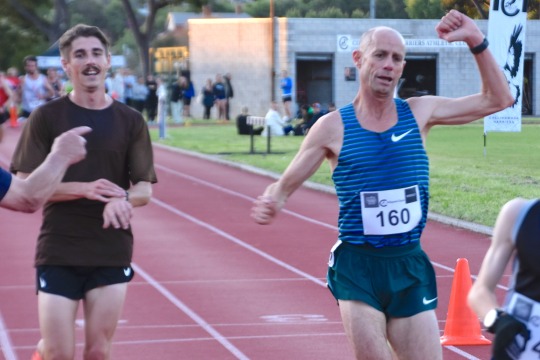
Steve was ecstatic after the race because his time broke the previous world record for his 60+ age group by more than three seconds. But a day later, Steve's Instagram post carried the news that the meet "wasn't sanctioned for WR or Oz (Australian) record". So it appeared that his great run would only be recognised as a State (Victorian) record.
This news rang a bell for me because in the 2018 Toronto Marathon, I ran with American runner, Gene Dykes, who shortly afterwards set a 70+ marathon WR in Jacksonville, Florida. He later found that the race had not been sanctioned by USATF, the governing athletics body in the USA. As far as I know, Gene was never recognised as the WR holder, and his time has now been surpassed by a Dutch runner, who ran 2:54.19 earlier this year.
But the marathon is a road event and we all know about the distance certification requirements for road races so that there is never a repeat of Alberto Salazar's overturned marathon WR in 1981. Surely there is no such issue with track records, so why was Steve so concerned about the sanctioning issue? Setting a world record on the track should be pretty straightforward, shouldn't it? As long as the track is 400m around, and you run faster than anyone else has ever run for the distance, then you are a world record holder, right? Well maybe, or maybe not ...
Here's how it works in Victoria (and I assume the other Australian states) for track record claims. For any given track meet, a state athletic body can issue a "State Permit". Performances at a State Permit meet can be submitted as State records or national qualifying times. In order for an Australian record claim, the relevant meet must have a "National Permit" from Athletics Australia. The Clifton Hill meet had only a State Permit, which is why Steve thought that he could not claim an Australian record. And the Clifton Hill meet could never obtain a National Permit because the track has only six lanes.
But wait, this is not the end of the story as far as Steve's record claims go. The State and National Permit requirements only apply for open age and underage records, not Masters records. Clyde Riddoch, the Records Officer for Victorian Masters Athletics, has assured me that Steve's performance will be recognised as State and National Masters records "as long as the paperwork is in order". Steve's run was hand timed and three different timekeepers were required to have recorded his time, among other requirements. The organisers of the Clifton Hill meet shrewdly engaged highly qualified Athletics Victoria officials to oversee the meeting, and as a result there is no doubt that the paperwork will meet the required standard.
That just leaves the big one - the world record. Will World Masters Athletics recognise a hand timed performance on a six lane suburban track at an unsanctioned meet (i.e. a meet without a National Permit)? Here's the advice from Hazel McDonnell, the Secretary of Oceania Master Athletics:
"When the record was obtained there are certain forms to be filled out and verified by the officials at that time. These must then go through your state statistician to be verified again and then onto your National body who will lodge it with WMA."
Keith Bateman is another very fast Australian senior citizen. He holds numerous State and National overage records, and most importantly for this article, the M55 world records for every track distance from 1500m to 10,000m - a truly incredible feat. And here's the good news for Steve: not all of these records were set at National sanctioned meets, but were accepted by WMA as world records nonetheless. In other words, the record requirements for Masters are less onerous (and bureaucratic) than for open and underage athletes, something of a seniors concession if you like.
Time will only tell as to whether Steve's mighty run will gain WR status, but Keith's experience gives great cause for optimism. But even if WMA does not recognise the performance, all of us who were present to witness it greatly enjoyed the chance to watch a true champion in action and yell: "Go Mona!" again, just like we did at Olympic Park all those years ago.
#moneghetti#worldmasters#worldmastersathletics#world record#5000m#track&field#trackandfield#distance running#athletics#athleticsvictoria#genedykes
1 note
·
View note
Photo

सुपर दादी भगवानी देवी जी के अविश्वसनीय और अदम्य इच्छाशक्ति को मेरा सलाम।
फिनलैंड में आयोजित #WorldMastersAthletics प्रतियोगिता में भारत के लिए 1 स्वर्ण और 2 कांस्य पदक जीतकर एक बार फिर यह प्रमाणित किया कि लक्ष्य प्राप्ति की ओर उम्र की कोई सीमा नहीं है।
#IndianSports @narendramodi @ianuragthakur @TawdeVinod @BJP4India @PMOIndia #BJP4India #VinodTawde #विनोदतावड़े
0 notes
Photo

सुपर दादी भगवानी देवी जी के अविश्वसनीय और अदम्य इच्छाशक्ति को मेरा सलाम।
फिनलैंड में आयोजित #WorldMastersAthletics प्रतियोगिता में भारत के लिए 1 स्वर्ण और 2 कांस्य पदक जीतकर एक बार फिर यह प्रमाणित किया कि लक्ष्य प्राप्ति की ओर उम्र की कोई सीमा नहीं है।
#IndianSports @narendramodi @ianuragthakur @TawdeVinod @BJP4India @PMOIndia #BJP4India #VinodTawde #विनोदतावड़े
0 notes
Photo

@rittethomas ・ #fortyandfit #europeanmastersathletics #worldmastersathletics #scbayer05 #vaultermagazine https://www.instagram.com/p/BzGVDKjnROV/?igshid=hdl3j3bbi521
0 notes
Photo

I have decided I will be competing at the World Masters Athletics Track & Field Championships hosted by Toronto in 2020, July 20 to August 1. http://wmatoronto2020.com/ I have just about two years to prepare. Time to bring it back old school. I am a competitive person and always will be. I have been waiting on something big like this. So why not? I hope my competition is preparing. I may be at a disadvantage due to my 200lb+ mass but I make up for it in heart and passion. If this old man does not have any sprains or tears, competitors are in for a challenge. I will definitely bring chiro and manual therapist extraordinaire @drliza on board to help along the way. I will be competing in the 400m. I am also considering the 200m, long jump, and shot put or javelin. Now I have to decide which spikes I will use. Old School New Balance A or New School Asics B? #toronto #trackandfield #wma #track #sprints #athletics #mastersathletics #worldmastersathletics #championships #sprinter #jumper #thrower #spikes #shoes #newbalance #nb #asics #drliza #whynot
#toronto#trackandfield#wma#track#sprints#athletics#mastersathletics#worldmastersathletics#championships#sprinter#jumper#thrower#spikes#shoes#newbalance#nb#asics#drliza#whynot
0 notes
Text
World Masters Cross Country Championships preview part 4
With statistical assistance from Scott Lawrence
With just one sleep to go until the 2k relay and two sleeps to the individual Sunday races, let's have a brief look at the 70+, 75+ and 80+ age categories. These groups compete over a shorter distance - 4k as opposed to 6k - and the fields are predictably smaller, but the rivalry will be just as strong.
The M70 field features two athletes with vastly different backgrounds, but impeccable distance running credentials. John Bermingham (NT) won two world championshipship gold medals in Finland last year (1500m and 10k road) and will start as favourite. Yassine Belaabed has set a string of Victorian M70 distance records over the last year and will keep John honest. Hard to prdict who will follow these two runners home - perhaps former Olympian Chris Wardlaw (Vic) or Ron Schwebel (NSW).
(L to R) Bermingham, Belaabed, Schwebel

There are only two W70 entrants, so both are guaranteed to win a medal! Canadian Thelma Wright may have the edge over Heather Powrie (NSW).You will understand why I make this suggestion if you look up Thelma’s Wikipedia entry. She is one of the all-time greats of Canadian distance running. In 1970, she won a bronze medal in the open age World Cross Country Championships in France. It is wonderful to see her in Australia for this event 43 years later.
There are five entries in the M75 event, all Aussies. Frank Scorzelli (NSW) has recently run 22:01 for parkrun so he will start as clear favourite. Phillip Urquhart (Vic) is extremely well known in Masters ranks as a former President of AMA. The form of the other three runners is unknown. There are no W75 entries.
(L to R) Scorzelli, Urquhart
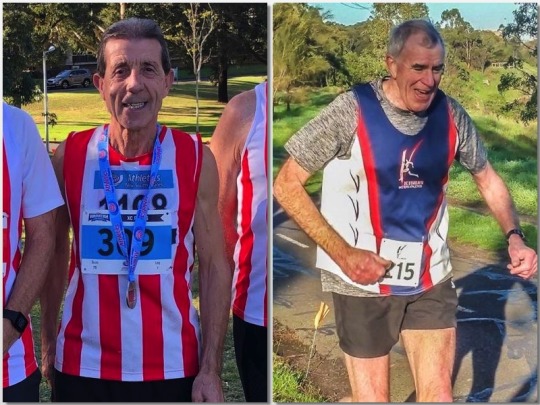
There are six 80+ entries, three men and three women, which is well organised by them because, as long as they finish, they will all get to stand on the podium. One name among them is famous, very famous. New Zealander Roger Robinson has so many great achievements in the sport that it would fill several pages to list them all. We can be sure that he will come to the event very well prepared and I’m nominating him as the likely M80 winner. Caroline Campbell (ACT) is a 1500m bronze medallist from the World Masters T & F Champs in 2018 and she will battle it out with Myrtle Rough, who was recently named the New Zealand masters middle distance athlete of the year. Roger and Myrtle should easily win the 80+ 2k relay.
(L to R) Robinson, Myrtle

Finally, and what a way to end this series of race previews, we have the oldest man in the field and the only 85+ entrant, Lachlan Lewis. He will win.
#mastersathletics#worldmastersathletics#world championship#cross country running#cross country#distance running#health#fitness#bathurst
1 note
·
View note
Text
World Masters Cross Country Championships preview part 3
With statistical assistance from Scott Lawrence
There are now just five days until runners and fans converge upon Bathurst for the World Cross Country Championships. My previews have focussed on the Masters 6k races because the 2k relay teams largely remain a mystery to me. But a few enquiries have revealed some interesting pairings. In the 40+ division, it has been confirmed that Ben Bruce and April Lund (USA) will run as a team and they should clean up. Steve Dinneen and Anna Kasapis are the strongest Aussie pairing, followed by Nathan Crowley and Nicole Joseph. These four runners are all from Victoria and I'm not aware of any teams from other States that might challenge them.
(L to R) Dinneen, Kasapis, Crowley, Joseph
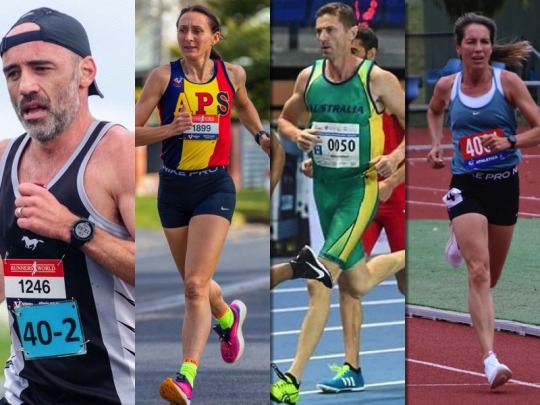
In the 50+ category, Steve Moneghetti has thrown the cat among the pigeons by dropping down from his 60+ age group to team up with Krishna Stanton. A clever move from the master of Masters! But I fancy the chances of Victorian duo, John Meagher and Julie Norney, who have an age advantage over this all-star pair. In a remarkable coincidence, Krishna and Julie ran identical times in their most recent parkruns (18:56), so will Mona have the speed over 2k to beat his younger rival? I am going out on a limb and tipping an upset by the younger team. Ant Rickards and Bev Thomas (also Vic) are the likely third team on the podium. Krishna's presence should at least prevent a Victorian sweep of the medals.
(L to R top) Moneghetti, Stanton, Meagher
(L to R bottom) Norney, Rickards, Thomas
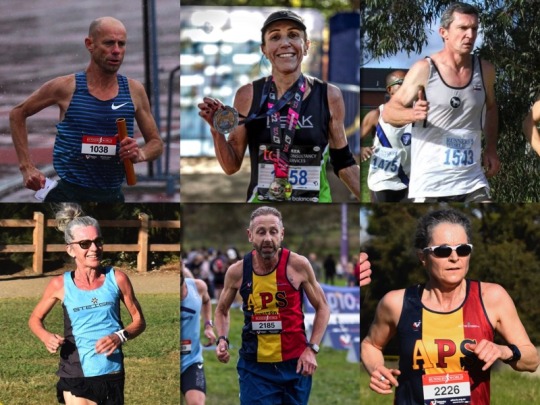
Now we return to the 6k individual cross country and the top 60+ and 65+ prospects. There are only three overseas M60 entries and it's a shame that most of the best runners in this age group appear to have preferred to enter the World Indoor Track Championships in Poland next month. Nonetheless, the field remains of high quality. Mona, fresh from his 5000m world track record, is the hottest of red-hot favourites. In an ominous sign for his rivals, when asked recently about the upcoming race, Mona simply volunteered: "I like cross country", four words carrying a very clear message to his rivals, among whom will be Bruce Graham (ACT), the winner of numerous Masters track titles over many years, and Derek Froude, a two time Olympian for New Zealand but now representing the USA. Craig Downie (Tas) is another elite runner, with recent times of 10:08/17:47 for 3000m/parkrun to his name. Gary Mayor (Qld) ran 17:35 for 5000m last year and so is also a chance for a medal.
(L to R) Graham, Froude, Downie, Mayor
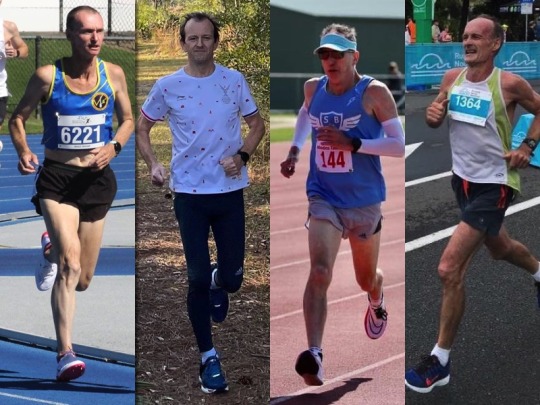
The W60 field is not nearly as strong and has no foreign runners, so is a de facto Australian Championships. Victoria Gunn (Tas), or Vicky to her friends, ran 21:06 and scored an age grading over 90% at the Launceston parkrun last year, which probably makes her (what else?) a gun runner. Robyn Basman (NSW) has a similar 5000m time from 2022. Anne Lord (Vic) is a four-time Australian World Cross Country representative. The other runners have little or no form on the board, so there could easily be a surprise win here from someone sneaking under my radar.
(L to R) Gunn, Basman

How good it would have been to see the two outstanding M65 runners in the world going head to head in Bathurst? But alas, it's not to be, as NSW's own Keith Bateman and Scotland's Alistair Walker are both skipping the event, unfortunately. This leaves Allan Long (formerly NT, now Vic) as the clear favourite. Ian Calder (NZ) and Peter Hutton (NSW) are experienced Masters competitors and should both be in the mix. In the W65 age group, Rosemary Roediger (NSW) has a strong claim with recent parkrun times just beyond 21 minutes and consistent 90%+ age gradings, but New Zealander Christine Adamson will be close by. Great Britain and Northern Ireland's Margaret Phillips boasts an impressive 441 parkruns to date, but she cannot match the speed of Rosemary or Christine. Helen Stanley (Vic) is another respected Masters competitor. Calder and Adamson will be a chance to win the 60+ 2k relay if they team up, although the younger pair of Downie and Gunn could conceivably take the gold medals back with them to Tasmania.
(L to R) Calder, Hutton, Adamson, Stanley

I hope that you are enjoying these event previews. The final episode in these series will look at the 70+, 75+ and 80+ divisions, where the race distance drops to 4k. Until then, keep on running!
#cross country running#mastersathletics#worldmastersathletics#world championship#longdistancerunning#health#fitness
0 notes
Text
World Masters Cross Country Championships preview part 2
With statistical assistance from Scott Lawrence
This blog episode will cover the 50+ and 55+ age groups. But first I owe a sincere apology to one of Australia's best ever cross country runners, Anna Thompson Munro. I have known Anna for about 25 years, yet I entirely missed her entry in the W45 events at Bathurst. My feeble excuse is that she entered as Anna Munro, whereas for years I have known her as Anna Thompson. Once alerted to my omission, I hastily consulted Wikipedia, which listed five of her appearances for Australia in the World Cross Country Championships. I subsequently learned that Anna has competed in the World Cross Country nine times! She represented Australia seven years in a row from 2002 to 2008, then again in 2010 and 2011, an extraordinary record. Her contest with Anna Kasapis in the W45 race should be a beauty.
Anyway, let's get back to the other age groups. The M50 race sees six countries represented. New Zealander Wim Luijpers has great recent track form, running 4:12 for 1500m in November. He will start as favourite. If someone travels halfway around the world for a 6k race, it's a fair bet that they might be a serious runner, and it looks that way for Frenchman Frederic Gilbert, who ran 4:22/9:15 for 1500m/3k indoors last year. Victorian Ant Rickards last week ran 16:49 for 5000m. He and another Victorian, Andrew McEvoy, who had a strong winter in 2022, are likely to be the nearest challengers to the two overseas visitors. Richard Hope is a former Victorian half marathon champion, but his current form is unknown.
(L to R) Luijpers, Gilbert, Rickards

There is only one foreign W55 entrant, so the race is likely to be yet another showdown between two Victorians, who have raced each other many times over the years, and a New South Wales speedster. Julie Norney Petrie has been in sparkling parkrun form of late, while Bev Thomas is a proven cross country runner. The two met twice in Victorian cross country events last winter - Bev beat Julie over 12k, while the result was reversed over 10k. This should be another great contest. Charlotte Middleton (NSW) is the dark horse, with outstanding 800m/1500m times in 2022, but she may be better suited to the 2k relay.
(L to R) Norney, Thomas, Middleton
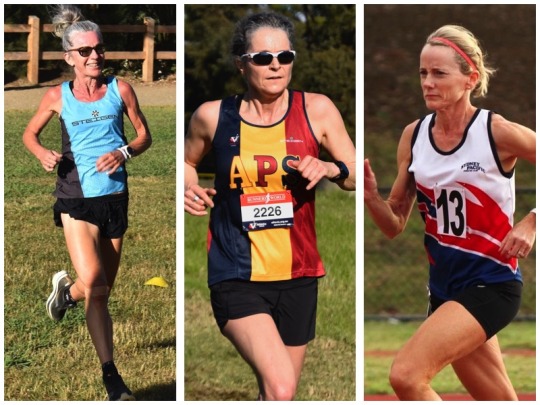
Well, what an interesting line up we have in the M55 category. A few overseas runners, but the locals will dominate. Shaun Creighton (ACT) needs no introduction. What a career he has had, both as an elite open age athlete and then as a reborn 50+ runner. Lately Shaun has been running big distances and looks to have peaked nicely for this one. I think he is close to the hottest favourite in any of the overage divisions. The podium places will be hotly contested. Paul Arthur (NSW) is a former City to Surf winner and it's good to see him back in action. He will have strong opposition from John Meagher (Vic). I expect to see these three guns take the medals, but Michael Eury (Vic), Ken Wilson (NSW) and Bruce Davie (Vic) may not be far behind.
(L to R) Creighton, Meagher, Eury

In the W55 race, it's impossible to ignore Krishna Stanton (ACT now Qld). She was already famous as a Commonwealth Games silver medallist, Olympian and Australian champion at various distances. Then, from seemingly nowhere, Krishna set a world W55 marathon record in London last year. She looks impossible to beat here. Liz Miller (NSW) is another former Australian representative, but her form is unknown. If she is fit, the podium beckons. Englishwoman Julie Wilson is the only overseas entrant and she has a recent fast 3000m time, as does Karen Blay (NSW), so look for either or both to challenge for a medal.
(L to R) Stanton, Blay

So that's it for part 2 of this series. Part 3 will feature the 60+ and 65+ events. Please feel free to comment on these predictions on the usual social media platforms, especially if I have left out any nine-time Australian cross country representatives! Until next time, keep on running ...
#mastersathletics#worldmastersathletics#world championship#distance running#cross country running#health#fitness
1 note
·
View note
Text
How much racing is too much?
There are many different schools of thought when it comes to frequency of racing. Many coaches seem to err on the side of caution, and will instruct their athletes to race infrequently, or only when they are “ready”. This is understandable, because no coach wants to be seen to be seen as responsible for an injury to an athlete.
But is there really such a thing as “over-racing”? In nearly forty years of competing, I do not recall ever suffering an injury in a race, other than the minor grazes and scratches that come with the occasional fall. My running injuries have generally been sustained during training sessions, or simply as the result of wear and tear (i.e. an over use injury).
It was the extraordinary Gene Dykes, the 70 year old running machine from Philadelphia, who caused me to consider the virtues and perils (or pros and cons) of frequent racing. Gene recently posted his proposed 2019 racing schedule on his Facebook page. It revealed a schedule that would challenge a super fit 20-something athlete, much less a 70 year old.

Gene plans on running 35 races this year, including five marathons and 13 ultra marathons. The total distance to be run in these 35 races is around 2,200 kilometres. Gene’s average yearly training mileage has been around 4,000 kilometres (80 km per week), which means that more than 50% of his total mileage for 2019 will be done in his races.
But this is nothing new for Gene. He ran his first marathon in 2006, aged 58. In the twelve years since, he has run 63 marathons and 47 ultra marathons. That’s around nine races per year of 42.2 km or longer. In that time, he has improved his marathon time from 3:42.55 to 2:54.23 (his recent world 70+ record which is not being recognised). Does this mean that racing frequently over long distances is the secret to setting PB’s, decades after most runners have given up on ever running another PB?
Gene had a stellar year in 2018, a year in which he ran even more races than he intends running this year. Gene participated in 45 races last year, including seven marathons and six ultra marathons. I use the word “participated” because he did not race them all. For example, although it is hard to believe, on the Saturday and Sunday two weeks before his world record, Gene ran both the San Francisco Marathon and Vista Verde Skyline 50 km as training runs. So that was 92.2 km for the weekend two weeks before a world record attempt! And the Vista Verde event included 1,785 metres of climbing! So it appears that the more this amazing septuagenarian runs, the better he races.
I have always been a frequent racer. Some of my closest friends would say that is because I am over-competitive, with a severe case of white line fever whenever I stand on a start line. Since my 50th birthday, I have had two standout years - 2013 and 2018. When I looked back over my running diary, something stood out in both years. It was the frequency of my racing. In 2013, I raced 41 times and last year, 46 times. Of course, I am no ultra runner and so my race distances were much, much shorter than Gene’s. My longest race in 2013 was a half marathon. In 2018, it was my one marathon.
But in 2018, despite the stark difference in the length of our respective events, Gene and I had this in common - on average, a race nearly every week of the year. Unfortunately, unlike late starter Gene, I am never going to run any more PB’s. In 2013 and 2018, however, I was achieving age gradings well beyond those earlier in my running career. On this basis, in both years, I was running better than I was when I set my lifetime PB’s in my 30′s.
I am therefore convinced that, by running as many races as possible, long distance runners, with their slow twitch physiology, give themselves the best possible chance to reach their full potential. And this conclusion is supported by both my and Gene’s recent running data.
The naysayers will point to an increased injury risk. I disagree, as long as you race smart and don’t go into a race carrying an injury. Others will say that you need to build up your fitness first. Again I disagree, because nothing gets you fitter faster and more efficiently than good, hard racing.
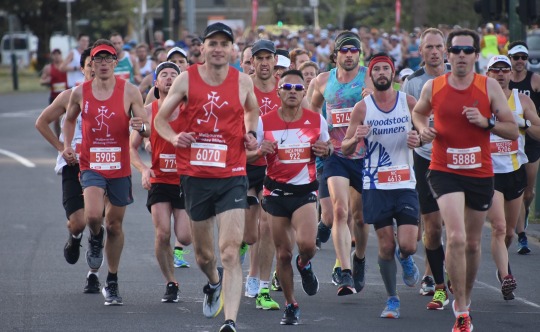
I am not suggesting that someone new to running should race every week from the time they first put on a pair of running shoes. But with a solid training base and a good balance of frequent racing, training sessions and recovery days, PB’s will follow, like night follows day. And let’s face it, I am yet to meet a runner who doesn’t enjoy competing against other runners and the clock to bring out the best in themselves.
Gene’s 2018: 23 road races, 13 trail/cross country races, 7 track races = total 43. Longest race 160 km. Total race distance 1,180 km = average 27.5 km per race.
Mark’s 2018: 7 road races, 12 cross country races, 11 parkruns, 16 track races = total 46. Longest race 42.2 km. Total race distance 347 km = average 7.5 km per race.
Until next time, long may you run.
#distance running#longdistancerunning#Roadrunning#roadracing#cross country#track#trailrunning#ultramarathon#ultrageezer#genedykes#marathon#world record#running#athletics#mastersathletics#worldmastersathletics#health#fitness
1 note
·
View note
Text
Treading dangerously in Toronto
Some men are seduced by money, power, beauty or love. But for distance runners, there is another seductress, another temptress, another siren on the shore. Her name is the marathon and she is dangerous.
In mid September I returned from the World Masters Track & Field Championships, feeling that I had not done justice to nearly nine months of dedicated training. The heat had been my enemy in Spain and I was glad to be back in Melbourne’s cool climate. But what to do next? I felt incredibly fit and had no niggles or injuries. I wanted to take advantage of this before anything went wrong.
Then the seductress came to me and put me in danger. The Melbourne Marathon was four weeks away. I decided that three weeks of high mileage would be enough, on top of the previous eight months of around 80 kilometres per week, to have me ready to race 42.2 kilometres. This is what the marathon does – she distorts a runner’s thinking, she makes him believe things that do not stand logical scrutiny. She is dangerous.
What followed was akin to cramming for an exam. Three weeks of more than 100 km, including one week of 129 km, my heaviest training in more than 20 years. I did a killer 20 km interval session called “Bevo Badness”and completed three long Sunday morning runs of 30 km, 30 km and 37 km. The last of these was run just a week before the Melbourne Marathon. It might sound a lot, but no serious runner would consider this to be an adequate preparation for racing 42.2 km, but I had been bewitched by the marathon and could not see the danger.
Then the Melbourne weather forecast went from bad to worse. I knew that a hot day would put paid to any chance of me running a reasonable time. I have never handled warm conditions well. I did not want a repeat of my failure to finish the World Masters Half Marathon in Malaga just a few weeks earlier. But my cunning seductress had a solution to this. Earlier in 2018, World Masters Athletics had awarded the first ever World Masters Marathon Championships to Toronto, and the event was to be held on 21 October, a week after Melbourne.
So I decided to ditch Melbourne and go instead to Toronto, where it would be cool. The course appeared relatively flat and conducive to fast times. It was the venue of Ed Whitlock’s incredibly fast marathons. Best of all, I might have a chance to win a Masters World Championship medal, something I had failed to do at three Masters World Track & Field Championships. And finally, I would get an extra week to taper for the race. What could possibly go wrong? In my seduced state, it all made perfect sense. There was no danger.
I flew to the USA six days before the race and spent three days near Boston, first with Aussie expat Ross Hooley and then with Bostonian friends Laura and Kevin O’Sullivan. Their kind hospitality allowed me to relax and enjoy myself, rather than stressing about the upcoming race. The cool autumnal weather made training runs a pleasure, building my confidence further.
Then followed a short flight to Toronto, where I had been incredibly lucky to secure a billet with a local runner, Frances Enchin. Despite not knowing me at all, she welcomed me happily into her lovely home. I arranged to meet an old friend for coffee, Shaun Creighton, whom I had not seen for many years. Shaun, a champion athlete with a 2:10 marathon to his name, was shooting for an M50 Australian record in Toronto. It was wonderful to meet his wife Stella, who was also running, and their beautiful livewire daughter Gretchen. As an added bonus, current Aussie marathon star Jess Trengove and her partner, Dylan Stenson, joined us for coffee. It was fascinating to listen to Jess and Shaun discuss their race tactics, with the possibility that they might run together for the first half of the race.

Shaun and I briefly ran around parts of the course on Saturday morning, but I found it hard to get any sense of the route or its gradients. The course profile map did not indicate any major hills. The weather was benign. I was feeling great. All of this is typical of the marathon’s seduction technique, which causes a runner to be filled with optimism, leaving him blind to the hazards.
Sunday morning dawned fine and cold, but it did not seem as cold as the forecast 2 deg C. The reason for this soon became apparent. It was windy. As I waited for my Uber to arrive, I watched the autumn leaves scudding down my street. This was not good, but hopefully the tall city buildings in downtown Toronto, where the race started and finished, would help to shelter us as we ran.
I wondered if I should alter my race plan, which was to run 5 km splits of 20:50 (4:10 per km) to reach halfway in 87:55, then run the second half of the race in around 89 minutes (at 4:15 per km) to finish with a total time of around 2:57. This plan was born of a desire to break the existing Victorian M60 marathon record, which stood at 2:57.25. I also believed that 2:57 would give me a strong chance of a podium finish, and might even see me challenging for the win in my age group. But bewitched by the marathon’s spell, any thoughts of changing my race plan vanished almost as soon as they arrived.
When I had told Shaun my target time the day before, he had suggested that I should look out for an old bloke with pure white hair and try to run with him. The old bloke’s name was Gene Dykes, a 70 year old from Philadelphia, who was aiming to break Ed Whitlock’s M70 record of 2:54.48. This was amazing news, given the superiority of Ed’s times over any other performances by septuagenerian athletes, before or since. In my marathon stupor, Shaun’s suggestion seemed eminently reasonable. Whispered the seductress in my ear: “There’s not much difference between 2:57 and 2:55”.
From the gun, I had a nice clean start. The marathon and half marathon runners all started together, but I did not encounter any real congestion. The fields were fairly small by international standards, with less than 4,000 runners competing in the marathon.
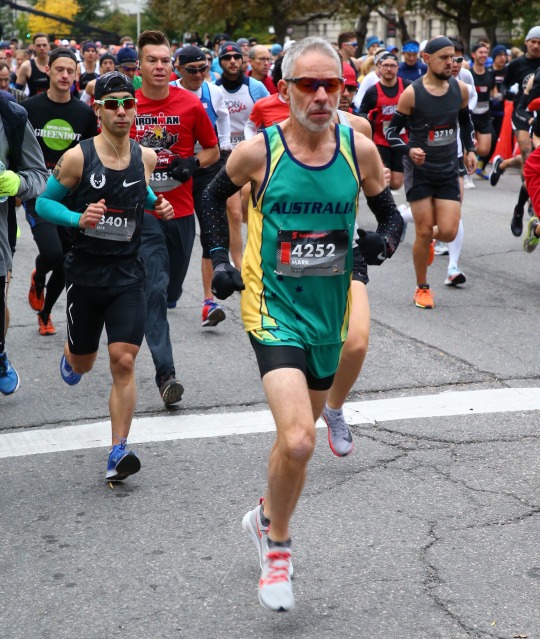
Within a kilometre or two, I spotted a white haired runner ahead of me, going at a very good pace. An official photographer on the back of a motorbike was next to him and I heard him say to the rider: “That’s him, I’ll get some shots.” I knew that I had found Gene. I ran behind him and admired his fluent style and long, toned legs. He reminded me of former Australian distance star Andrew Lloyd because his legs seemed a little too long for his torso.
I fell in beside him for a chat. We discussed our respective goals and he asked me whether I was going to draft off him! I suggested that we might draft off each other, but as the race went on, it became clear that Gene was the principal pacemaker. He was relentless. If the pace slowed at all, he would pick it up again. So that’s how, at 61 years of age, I came to be drafting behind a 70 year old in the Toronto Marathon!

I know that good marathon runners stick to a plan. A successful marathon requires being faithful to a plan despite distractions. Many runners get carried away in the initial opening rush, while others expend too much energy in the first half of the race. As Gene and I ticked off the kilometres, I noted that we were hitting each 5 km split in around 20:40. I felt strong through to halfway in 87:29. This was 26 seconds ahead of my planned pace. I had not stuck to my plan. I justified this by telling myself that this was good, I now had plenty of room for a slowdown later in the race. The marathon is adept at leading runners into self-delusion.
Just before halfway, we lost the company of the half marathon runners, who were diverted to their finish line. Gene and I hadn’t spoken for a while, but at halfway, he asked me what our time was. When I told him, he exclaimed that it was too slow and he would miss the M70 record. He then upped the pace for a couple of kilometres at a point when I would have preferred to back off a little. So, was I smart enough to let him go? Of course not. I went with him to 30 km, but by now was working really hard to maintain his pace of around 4:09 per km.
An English marathon runner, Jon Brown, has written this about the marathon:
“The cruellest trick that the marathon likes to play on runners is letting them believe that they feel good, especially in the middle part of the race. Once past the halfway point, the marathon plants the idea into the heads of many runners that they are ‘almost there’ and they can start thinking about finishing. Never trust the marathon. Between kilometres 30 and 40 is where the marathon really enjoys itself, this is what it lives for. The dual combination of physical breakdown and reduced mental function make runners easy prey. Never trust the marathon. It is here where those who have diligently stayed true to their meticulous race plan experience the epic carnage all around them, as the marathon’s invisible lasso brings down the reckless and over-confident.”
Hitting the wall is the point at which the marathon loses her allure, and you recognise her for the devious adversary that she is. You suddenly move from running confidently and strongly into a state of physical and psychological meltdown. This is not a gradual happening to which you can adjust and then reset your goals. There is no warning, and there is not a damn thing that you can do about it except hang on for dear life.
After 30 km, my 70 year old companion left me behind. I slowed to 4:18 per km between 30 and 35 km as we turned into a significant headwind. The regular hills on the course (which was nowhere near as flat as I had been led to believe) had also taken their toll. At around 34 km I felt a wave of intense fatigue and I knew at once that I had hit the dreaded wall. My long marathon experience has taught me that hitting the wall can take many forms, from a simple loss of energy to something more serious like an injury of some kind.
This time, my meltdown was characterised by shooting pain in both quadriceps and adductor muscles. I blew out to more than 4:30 per km between 35 and 40 km. At around 40 km, there was a bridge. As I ran downhill off the bridge, it felt like hot pokers were being jabbed into my quads with each step. It really, really, really hurt. Finally the road flattened out and I ran the last kilometre swearing continuously under my breath: “Holy s--t, holy s—t, holy s—t” in an effort to distract myself from the pain. But it worked, suddenly I was there, it was over. My time was 2:58.48.5, under three hours, thank goodness.

I hobbled back to the Sheraton Hotel, where I had left a change of clothes with Shaun. Another Aussie, Russ Jenkins, saw me in the foyer and told me that I had won a bronze medal in my World Masters age group. Suddenly the pain in my legs didn’t seem so bad. I met up with Shaun, who unfortunately had blown up after a fast start but still won his M50 age group. Stella had won the W50 division, giving them a golden double. I found out that Jess had run brilliantly for a new PB of 2:25.59, finishing as fourth female and 23rdoverall. Russ himself had missed an M55 medal despite running an excellent time of 2:49.
A scan of the results and race photos revealed some interesting information. Unfortunately and inexplicably, the race organisers had not thought to put runners’ age groups on their bibs, a strange omission in a Masters World Championship event. Consequently, throughout the race, I had no idea whom I was racing against and whether they were near me at any stage. My race photos revealed that the winner of my division, Josef Siegel from Poland, had been running with or close to me for the majority of the race! We were the co-leaders of the M60 division from the 20 km mark to 35 km, but we were both blissfully unaware of this. Josef is number 3412 in the photo below. The picture features three athletes with a combined age of 191!
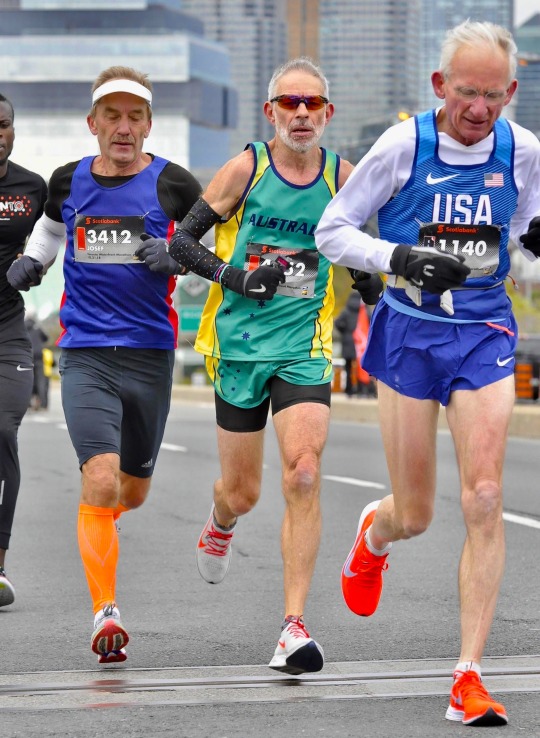
They say that a marathon does not really start until after the 32 km mark. This was certainly true of my battle with Josef. His winning margin over me of 1:12 was gained entirely in the last 7 km. The second placegetter, Miguel Diez Garcia of Mexico, who beat me by 36 seconds, was 56 seconds behind me at 35 km, but ran his last 7 km faster than both Josef and I. He overtook me with less than 2 km to go, but again I had no idea at the time that I was being passed by an M60 runner. Would it have made any difference? Probably not, but you can’t help but wonder whether I would have raised one final effort.

But I was well and truly trounced by Gene Dykes. He ran 2:55.18, missing Ed Whitlock’s freakish M70 record by just 30 seconds. His splits were 87:33/87:45. His age grading was 94.71%. It was a truly remarkable performance. I congratulated him after the race. When I told him I was 61, he said: “Just imagine how good you’ll be at 70!”
This story has been more than two years in the making. It was in September 2016 that I first set my goal of running under three hours for the marathon after my sixtieth birthday. There have been both triumphs and setbacks along the road since then. A fairytale ending in Toronto would have been to run under three hours, break the Victorian M60 record and win the World Championship and, although I went close to the last two achievements, they were not to be. And therein lies the rub – I now have unfinished business. So here is the marathon’s final carefully laid trap. She makes you believe that you can and will do better next time. So instead of lashing myself to the mast like Ulysses, I will return to her.
Her name is the marathon and she is dangerous.

#torontowaterfrontmarathon#marathon#worldmastersathletics#roadrunner#distance running#toronto#boston#shauncreighton#jesstrengove#health#fitness#personalbest#hittingthewall
0 notes
Text
The question is: why?
It’s Monday morning in Malaga, Spain, and I’m recovering from what turned out to be a very challenging 10 km road race yesterday. Without knowing my result, I had jogged back to my apartment, feeling less than satisfied with the whole exercise and seriously questioning whether the expense and travel hassles were really worth it. The problem was that the back end of my race had been poor, and that was what was fresh in my memory.
But let’s wind the clock back a few days. The journey from my front door to my accommodation in Torremolinos took 36 hours, a marathon in itself. There were four flights and three stopovers, so any sleep was fleeting at best. Nonetheless I felt OK on arrival and enjoyed meeting Andrew Kohlrusch, a decathlete from Sydney, with whom I would share an apartment for four days.
My first full day in Spain was the day of the cross country races. It was hot, really hot, but thankfully the course in a local forest was almost entirely shaded. It was dry, dusty and stony underfoot, not quite meeting the WMA rules which specify that World Championship cross country courses must be 85% grass! But I don’t think it rains much in Torremolinos. There isn’t much grass to be seen anywhere, so that rule was always going to be breached.
I cruised in my race, even finding time to smile for the cameras. The standard at the front of the race was pretty high. Two incredibly fit looking Kenyan athletes lined up for the start, but the other runners were quick to point out to them that they were in a later (younger) race, thankfully for us old geezers. One of these runners was Samuel Ndereba, who boasts a 10 km PB of 28:01!

Over the following three days, I did a road trip to the Altequera Natural Area, which featured a walking trail through impressive limestone stacks, watched the Melbourne vs Geelong game live on my computer (which I enjoyed somewhat), and then switched accommodation to Malaga.
Day 5 (Sunday) was race day. It dawned cloudy and fairly cool, which was good, but the cloud cover was patchy and bound to clear quickly. I jogged to the main athletics stadium where the race would start and finish. All the men aged from 30 to 70 would go off at 9.00 am, while the men aged over 70 and all the women would start at 9.10 am. The start was on the track itself, which meant that the 460+ men in my race were jammed in like sardines for several long minutes after the officials had pushed all the runners back behind the start line. On a humid and increasingly warm morning, the resulting body contact was most unpleasant for everyone.
Thankfully from the gun the runners fanned out across the track and there was a clean start. I settled in at a good hard pace and soon found myself locked on the shoulder of a Polish rival. I know that he was in my race because each runner’s bibs showed their age group. I felt that the pace was about right for my target of around 37 minutes, but I don’t look at my watch until 5 km. My judgment proved correct as I reached the milestone in 18:30.
Unfortunately from that point, the Pole began to get away and then an English 60+ runner passed me at around 6 km. It was getting much hotter as the cloud cover dissipated and the humidity seemed to rise. I was really finding it tough now. I concentrated on making sure that no other 60+ runners passed me, but a glance at my watch confirmed what I had feared was happening. My pace per km had slumped from 3:42 to the mid 3:50′s.
The stadium loomed ahead, thank goodness, but in a nasty twist, the course required us to go past it then do a full lap of the surrounding road. Finally we re-entered the stadium, did a full circuit of the track and finished. And when you are completely knackered, what’s the worse thing that could happen? Yep, some 60+ guy from Columbia tried to outsprint me in the last 30 metres. Well sorry fella, I might be stuffed but that ain’t gonna happen, and it didn’t. I later found out that although he had a race bib, he hadn’t entered the race, which was a trifle annoying, given the effort it had taken to beat him!
After the race, I tried to work out approximately where I’d placed by talking to the Pom who had overtaken me. It looked like sixth place was the best I could hope for, but I could well have missed out on the top ten, which had been another pre-race goal, given that on submitted times, I had been ranked around 15th fastest in the field.
Back at my apartment, I waited for the official results. Messages from home began arriving via Messenger, text and email, asking how I’d gone. Eventually they were posted on the championships website - sixth place, you beauty, my best ever placing in a World Championships. Suddenly I felt a whole lot better. Many congratulatory messages came from friends, which I loved receiving.

So the doubts which had surfaced on my jog home were banished and I look forward to my next race on Wednesday, which will be 5000m on the track. I had originally planned to do the half marathon next Sunday, but it is simply too hot and humid for this old runner coming straight from a Melbourne winter to endure 21.1 km of torture. It may even be too hot to run a decent 5000m, but at least I’ll only be out in the heat for a considerably shorter time.
And finally, to answer my own question: why? To quote Bruce Springsteen in his autobiography, there is still, after all these years “a furious fire in the hole that ... just ... don’t ... quit ... burning.” Hopefully it won’t go out for a while yet.
Until next time, long may you run (or, if you prefer, keep dancing in the dark).
#WMAC2018#worldmasters#worldmastersathletics#malaga#10kmrun#roadracing#roadrunner#mastersathletics#runblr#fitblr#athletics#running#distance running#health#fitness#Bruce Springsteen#torremolinos#halfmarathon#5000m#afl#melbournedemons#dees
0 notes
Text
Reeling in the years
I have been involved in competitive athletics for 35 years as a runner, team manager, administrator and mentor/coach. I first competed in open competition during the massive running boom of the early 1980′s, which flowered on the back of Jim Fixx’s best selling book and events like the Brisbane Commonwealth Games and Los Angeles Olympics. At the time, Australia had male and female marathon stars on the world stage, Rob de Castella and Lisa Martin/Ondeiki, while English middle distance runners Seb Coe, Steve Ovett and Steve Cram duked it out in the 800m and 1500m. The African dominance of distance running had not yet begun.

Questions have been asked about the lack of major Australian success in the marathon since the days of Deek and Lisa. Sure, we have had Commonwealth Games gold medallists, but it’s been a long time since an Australian was seen on the podium at a major city, Olympic or World Championships marathon. Steve Monehetti’s win in Tokyo in 1993 is now a generation ago. Can this be explained by the improvement in times at the elite level since African athletes entered the fray in large numbers, or has the standard of Australian athletics fallen away generally over the last 25 years? It cannot be suggested that participation in the sport has decreased, as all indicators clearly point to another running boom during recent years with the big city marathons experiencing unprecedented demand for places and smaller events like parkrun drawing huge numbers of runners.
It is difficult to compare performances in different years on different courses, but the Athletics Victoria 10 km Road Championship has been a consistent feature of distance racing in this city, always attracting the best local runners as well as some big names from interstate. So I decided to dig out the results since I first ran it in 1984 to see if any conclusions could be drawn from them. I had most of the results and local running legend Trevor Vincent was able to fill in any gaps.
My analysis is confined to the men’s results, as until 1990, there was usually less than 50 runners in the women’s race. It wasn’t until 2004 that numbers in the women’s race began regularly to exceed 100. Happily, since 2010 the women’s fields have grown to reach 200+ competitors. The men’s numbers, on the other hand, have generally varied between 400 and 600 in the surveyed period, with the exception of some lean years between 1997 and 2003, when the number of male finishers fell below 400.
The graph below charts the times recorded by the 10th, 50th and 100th placed runners in the men’s race from 1984 to 2018. I do not claim that the analysis provides a perfect comparison of times between eras because the race venue has changed several times and of course there are other factors leading to variations from year by year, e.g. weather conditions. The graph nonetheless reveals a clear trend, and that is that times at the top end of the field have been getting steadily slower.

The comparison of the fastest and slowest years is stark. In 1988, the times for 10th, 50th and 100th were 29:25, 31:12 and 31:48 respectively. The slowest year is 2016, with times of 31:05, 33:09 and 35:16. Both years featured flat courses - Caulfield and Albert Park respectively. Certainly Albert Park is more likely to be windy, but not to the extent that would explain such a large difference in times. The conclusion from the data is obvious and compelling: the standard at the “pointy end” of the AV 10 km is now significantly lower than a generation ago.
The 1988 race was remarkable in many respects. Steve Moneghetti, then aged just 25, won in a blistering 28:19 on the three lap course on the roads around the outside of Caulfield Racecourse. A time under 30:03 was needed to finish in the top 20. On a personal note, I clocked 31:31 and finished 88th! Another Midday Miler, Mike Bialczak, ran 30:48 and finished 53rd! Here is the first page of the results.
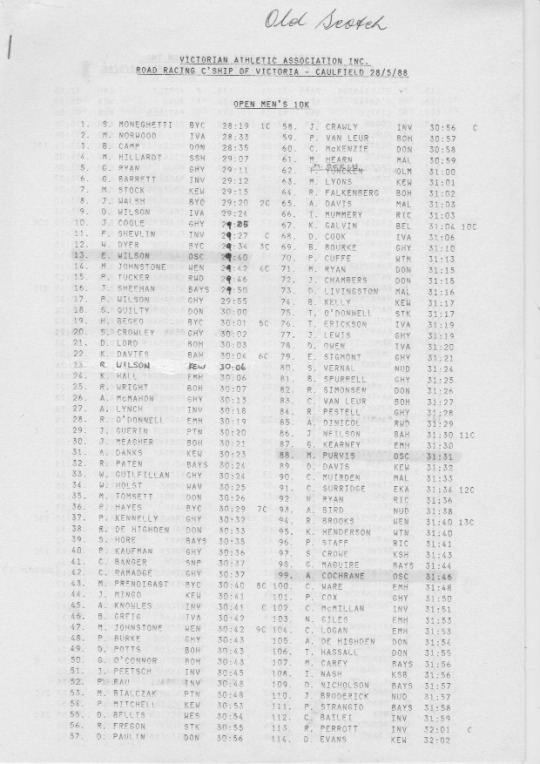
But there is light at the end of the tunnel. This year’s race boasted the second largest combined men’s and women’s field (739 runners) in the history of the event. As the graph above shows, men’s times are finally heading south after 25 years of deteriorating performances. Athletes like Stewart McSweyn (5000m 13:05) are recording outstanding times overseas. Hopefully the current running boom will bear fruit and Australia will again find some marathon runners who can mix it with the world’s best.
POSTSCRIPT: My last blog followed the 10 km road race at the Masters World Championships in Malaga, Spain. To bring you up to date, I followed up with a 10th placing in the M60 5000m in 18:35. Finally, I started the road half marathon in oven-like conditions, but elected to pull out at 16 km because a swim in the nearby Mediterranean was far more appealing!
Until next time, long may you run.
#marathon#10kmrun#championship#running#running boom#distance running#longdistancerunning#athletics#athleticsvictoria#mastersathletics#worldmastersathletics#albert park#malaga#health#fitness#deek#moneghetti#decastella#ondeiki#mcsweyn
0 notes
Text
The road to ... Toronto!
In comparative terms, my best results during my long running career have come in the marathon. The longer it gets, the better I seem to go. But every marathon extracts a heavy toll on the body. The required training is long and hard, and the race itself is long and even harder.
During my 30+ years of competing, I have started in 17 marathons and finished 15 of them. My last completed marathon was in Berlin in 2015. This year has seen my highest mileage for 20 years and best race results since 2013, and so thoughts of putting myself to the ultimate distance running test have again come to the fore.
My trip to Malaga prevented me from implementing a proper marathon build up, but I decided upon my return that with the miles in my legs plus some serious cramming in the last three weeks, it would be possible to tackle the Melbourne Marathon. I last ran the Melbourne Marathon in 1992 aged 34, finishing 16th in 2:25.20. The age grading for this performance was 84.83%.
The Melbourne event was an attractive proposition because it is on home turf and the race support from my Melbourne Midday Milers team mates is legendary. If conditions are good, fast times are possible on the course, despite the hills late in the race. And I wanted a fast time, at least sub 3 @ 61, but more ambitiously, the Victorian M60 marathon record, which currently sits at 2:57.25.
But after my unpleasant experience in the World Masters half marathon in Malaga, I had made a promise to myself never again to run a long distance race in temperatures above 16deg C. Time and again, my performances in hot weather have been very poor. Quite simply, I hate running in the heat. So from the start of the month, I began to follow the local weather forecasting websites. From the outset, it didn’t look good. Once we were within reasonable forecasting range, a prediction of 25deg C with strong 35-40 kph winds promptly scuttled my plan and I pulled the pin on the Melbourne Marathon.
But I had a plan B. Earlier this year, World Masters Athletics announced that, for the first time, there would be a World Marathon Championship separate from the World Track & Field Championships. Previously, there was always a marathon on the last day of the T & F Champs, which almost always meant a race in late summer heat, resulting in low entry numbers and slow times. The first nominated World Masters Marathon Championship race is the Toronto Waterfront Marathon on 21 October, just a week after the Melbourne marathon.
The Toronto course is reputed to be fast. The men’s and women’s course records are 2:06.52 and 2:22.42 respectively. The late Ed Whitlock set his incredible overage marathon records here (see my earlier blog about how much I hate Ed). This year, its reputation as a fast course has been enough to lure Aussie stars Jess Trengove and Shaun Creighton to run. Shaun is aiming to run under 2:30 and set a new Australian M50 record.
Most importantly, the weather will be cool. It is still too far out to have any confidence in the forecasts. One website says the temperature range will be 5-16deg C, another says 4-7deg C! I hope the latter prediction comes true. One thing is for sure, it will be much cooler than Melbourne. So I have entered the race and booked and paid for my air tickets. Toronto here I come!


As for my target time, the current Victorian record comes in at 85.5% age graded. So I will have to run comparatively faster than I did in Melbourne all those years ago. But my PB of 2:24.23 run earlier in 1992 converts to 85.39%, which is incredibly close to the grading that I need to achieve in twelve days’ time. But it does mean that I will need to run an age graded PB to get the record. Clearly this will not be easy, but I believe that Toronto’s cool conditions will give me my best possible shot. Wish me luck!
Until next time, long may you run.
#marathon#torontomarathon#melbournemarathon#worldmastersathletics#worldmastersmarathonchampionship#toronto#longdistancerunning#athletics#health#fitness#shauncreighton#jesstrengove#melbournemiddaymilers#weather#age grading#roadrunning#personalbest
0 notes
Photo

@usatfmasterstrack 2009 World Masters Athlete of the Year Rita Hanscom won Silver this morning (Sunday) in the W60 Pole Vault at WMAC Malaga. #WMAMalaga2018 #polevault #USATFmasterstrack #usatf #worldmastersathletics #wmac2018 #mastersathletes 📷 by @rjdavellar https://www.instagram.com/p/Bng-qS5hB9X/?utm_source=ig_tumblr_share&igshid=1frhmeurlyo44
0 notes